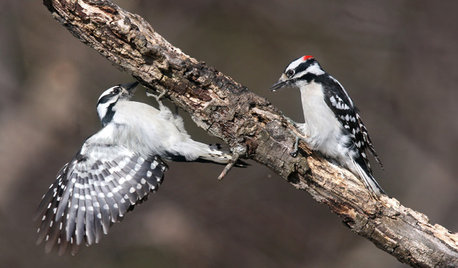Please help identifying a critter.
winsorw
9 years ago
Related Stories

GARDENING FOR BIRDSBackyard Birds: How to Identify Two Common Woodpeckers
Downy and hairy woodpeckers have similar coloration and behavior. But there are two big differences that separate them
Full Story
LIFEHow to Outsmart Backyard Critters
Learn to think like a raccoon, skunk or squirrel to keep your home safe and your garden intact
Full Story
SUMMER GARDENINGHouzz Call: Please Show Us Your Summer Garden!
Share pictures of your home and yard this summer — we’d love to feature them in an upcoming story
Full Story
GARDENING GUIDESGreat Design Plant: Snowberry Pleases Year-Round
Bright spring foliage, pretty summer flowers, white berries in winter ... Symphoricarpos albus is a sight to behold in every season
Full Story
ORGANIZINGHelp for Whittling Down the Photo Pile
Consider these 6 points your personal pare-down assistant, making organizing your photo collection easier
Full Story
EARTH DAYHow to Help Your Town’s Beneficial Birds and Bugs
Make a habitat using local materials to provide a home to the creatures that help our gardens
Full Story
LIFEDecluttering — How to Get the Help You Need
Don't worry if you can't shed stuff and organize alone; help is at your disposal
Full Story
ORGANIZING4 Questions to Help You Organize Your Favorite Photos
Organize your keeper photos with a system that's just right for you, whether it's in the cloud or you can hold it in your hand
Full Story
ORGANIZINGGet the Organizing Help You Need (Finally!)
Imagine having your closet whipped into shape by someone else. That’s the power of working with a pro
Full Story
GARDENING AND LANDSCAPINGBe a Citizen Scientist to Help Wildlife, Learn and Have Fun Too
Track butterflies, study birds, capture stars ... when you aid monitoring efforts, you’re lending Mother Nature a hand
Full Story








tanowicki
enith
Related Professionals
Cary Landscape Architects & Landscape Designers · Essex Landscape Architects & Landscape Designers · Lakewood Landscape Architects & Landscape Designers · Milford Landscape Contractors · Coram Landscape Contractors · Oviedo Landscape Contractors · Petaluma Landscape Contractors · Raleigh Landscape Contractors · Madison Fence Contractors · Grover Beach Fence Contractors · Madison Fence Contractors · Maywood Fence Contractors · Pensacola Fence Contractors · Ponte Vedra Beach Fence Contractors · La Puente Fence ContractorswinsorwOriginal Author
gardengal48 (PNW Z8/9)
winsorwOriginal Author
jeff-1010
Embothrium
plantknitter
Embothrium
gardengal48 (PNW Z8/9)
jeff-1010
mikebotann
gardengal48 (PNW Z8/9)
ken_adrian Adrian MI cold Z5
jeff-1010
buyorsell888
dbarron
morz8 - Washington Coast
zephyrgal
Embothrium
dbarron
mikebotann
Embothrium
plantknitter
mikebotann
Embothrium
mikebotann
Embothrium
mikebotann
pugetsoundgardener
Embothrium